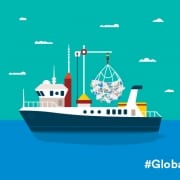Sourcing the right Eurozone market for your business
Exporting to the Eurozone makes sense for Irish firms for several reasons. We share a common currency. Trade within the Eurozone benefits from the absence of tariffs and customs. A common regulatory environment means that Irish goods and services comply with EU legislation.
The Eurozone offers ease of access to 340 million people in the 19 states that share the single currency and a stable economy that, as a bloc, will continue to grow a further 1.3% through 2019.
Although the Eurozone’s population is five times that of the UK, it accounts for only 20% of all Irish exports. As such, it presents what Minister for Trade Pat Breen T.D. described as one of the greatest sources of “untapped export potential” at Enterprise Ireland’s Eurozone Summit earlier this year.
How to find the right Eurozone market for you
Finding the right market fit for your exports requires groundwork and an awareness that Europe is composed of different economies and markets, each with its own advantages and barriers to entry.
In order to successfully enter Eurozone markets, all elements of new market entry preparations are required: market research to select the market with the best opportunities, a value proposition that matches the new market and highlights your competitive advantage, the right route to market, and the resourcing of people, skills and funding to make it happen.
Some countries have well-known strengths and sectoral specialisms. At the Eurozone Summit, delegates heard from market experts who outlined some of the major opportunities – and some of the risks – that member state economies hold for Irish exporters.
Opportunities across the Eurozone
Germany is the largest Eurozone economy and the world’s fourth largest. Famed for its manufacturing sector, there are also opportunities for Irish exporters in the automotive, pharmaceuticals and medical device sectors. As one of the biggest foreign direct investors in the Irish medtech sector, German firms are familiar with Irish innovation and regard it highly.
Accessing Germany requires breaking into long-standing supply chains built on loyalty and quality, with consistency a key driver for German consumers. Decision making and order lead-in times can be protracted but the Irish reputation for flexibility stands exporters in good stead.
While many German brands are well known internationally, the domestic economy is driven by SMEs or ‘mittelstadts’, Angela Cullen, Senior Editor at Bloomberg Frankfurt, told the Eurozone Summit.
“Thousands of them form the backbone of the economy and they have honed their products to be market leaders. Partnering with a German sectoral partner may be necessary to get a market foothold.”
The nearby Benelux countries are some of the most densely populated areas of the Eurozone, allowing the rollout of a product to a large cross section within a small geographic area.
The Netherlands has long positioned itself as the number one logistics nation of the Eurozone with Rotterdam often referred to as ‘Germany’s largest port’.
As well as being the first point of entry for many physical goods, the Netherlands acts as a first point of entry for data as it is home to some of the largest data centres in Europe. Irish construction consultancy and build expertise is valued by the Dutch, with the sector continuing to show growth, and Dutch firms focused on securing their design and build supply chains post-Brexit.
“It is an extremely developed economy that is open to business and used to working with partners so it is natural for the Dutch to partner with fellow member states to bring off a project,” Willem Noë from the European Commission in Ireland said.
Belgium is often said to be one of the best test markets for products, given its population mix, and can be an ideal testbed, Ruben Hamilius, managing director of Businessgames Ireland, told the event.
“But be warned, the biggest mistake I see is exporters think ‘Build it once, sell it forever’ but that is not really the case. You need to do your research, as the product fit may not be right. Belgium is great for that.”
It certainly suited Irish parking marketplace start-up Parkpnp, who rolled out its parking app tech in Belgium first, eschewing its home market and the UK. The company has now honed its product into a franchising model already in place in the Netherlands and is rolling it out into France and Germany after learning valuable lessons in the testbed market.
In France, local language skills can be crucial, while supply chains are generally built on face-to-face contact rather than via the internet.
Enterprise Ireland supports can help
Enterprise Ireland’s world-class Market Research Centre has extensive resources to aid your research, while our Excel at Market Intelligence programme will advise how best to conduct market research.
Our Market Discovery fund is a key financial support for new market entry, ensuring you have funding to research, get expert advice and conduct market study visits. GradStart provides up to 70pc of two-year salaries for graduates with relevant market language skills.
Companies we support benefit from our market advisers’ near-unmatched knowledge of market dynamics, target buyers, networks and ecosystems across six Eurozone locations. When you’re ready to enter the market, we offer a key manager grant to help co-fund the salary of personnel with the right skills to work with market advisers and drive your diversification plans.
These supports will help ensure you find the right market fit and “take advantage of the Eurozone”, as advised by the first President of the European Council, Count Herman Van Rompuy, at the Eurozone Summit.














